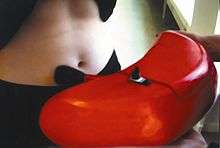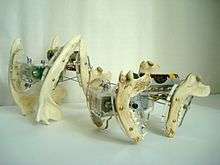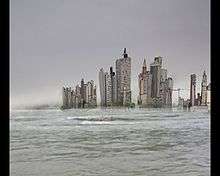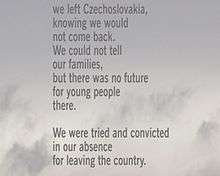Kaethe Katrin Wenzel
Kaethe Katrin Wenzel (born November 1, 1972, in Aachen) is a German artist. She works are about Utopian ideas, the future, and alternative concepts for society. Her main instruments are drawing, interviews, the Internet, mechanics/electronics, and street art. She uses techniques from surveys to speculative fiction to explore "the collective production of culture, the interface of art and science, and the production and negotiation of public space".[1] Her projects provide skeptical footnotes to global history.
Kaethe Wenzel | |
|---|---|
 Kaethe Wenzel (with Lisa Glauer): Egostroking Machine, 2007 | |
| Born | November 1, 1972 Aachen, Germany |
| Nationality | German |
| Known for | urban and participatory art |
She modifies or mimics urban signs, advertisements, or services, jolting viewers out of their habitual ruts, upsetting conventional ways of seeing and of representing the world. Her interview-based drawing projects connect the streets and the Internet. Her aim is to create space for unusual thoughts and empowered communication: "The point is to rewrite existing structures as alterable, to change and rethink them (...) Through a collective work process (Wenzel) opens up new perspectives and visions of specific themes."[2]
Wenzel often actively involves passersby in surveys or service interventions, testing machines of her own invention, or she interviews citizens as local specialists – experimenting with forms of collective authorship and working against traditional notions of artists as "visionaries" who are supposed to possess special insights denied to the "average person".
According to Wenzel, new ways of seeing, which are developing as part of the digital revolution, and of changing concepts of the urban realm are especially suitable for artistic infiltration to reflect the underlying structures of daily life.
Life and works

In 2016, Wenzel became professor for Aesthetic Practice and Contexts at European University Flensburg.[3] She studied in Marburg, Florence, and Berlin. In 2003 she received a PhD for her work "Meat as a Material in Art. Objects on the Interface of Art and Medicine" about oppositional artistic structures in the German Democratic Republic (GDR).[4]
She was an exchange scholar with the Fulbright Program at the School of Visual Arts in New York City, 2009–10. In a direct reaction to New York City she developed the Cartoonorama project, which combines drawing, interview, and cartography.
Her art can be found in numerous museums and collections: the German Museum of Technology Berlin;[5] the Szént István Király Múzeum, Székesfehérvár, Hungary;[6] the Koblenz Middlerhine Museum,[7] and the Roemer-Pelizaeus-Museum in Hildesheim.[8]
Notable works


- Future M (Internet and outside premises), 2016–, ongoing global project with interview-based animations about urban cultures/migration/chosen. Interview, drawing, animation, internet, signage, www.cartoonorama.de
- Pictures of Tomorrow (German Museum of Technology Berlin), 2011, series of 19 panes 190 × 115 cm, drawing, print, signs, and interactive web panorama http://sdtb.de/index.php?id=2159&type=0
- Last Exit Utopia (Public collection of the City of Viersen and Kunstverein Gütersloh), 2015, 60 signs, each 15 × 40 cm
Publications
- Kaethe Wenzel: Parallelgesellschaft Utopia – Last Exit Utopia. Catalog. Schoeppingen, Berlin 2015, ISBN 978-3-00-050545-4.
- Ellen Kobe, Marvin Altner (Eds.): "Neue Kunst in den Neuen Kammern." Foundation Prussian Palaces and Gardens, Jovis, Berlin 2008. ISBN 978-3-86859-030-2.
- Wolfgang Knapp, Cornelius Froemmel, Thomas Schnalke, Kaethe Wenzel (eds.): missing link – Kunst trifft Biomedizin. Public understanding of art and sciences – art meets biomedicine. Catalog about the exhibition at the Museum of Medical History at the Charité, Berlin. University of the Arts, Berlin 2008, ISBN 3-89462-133-8.
- Lisa Glauer, Tatjana Fell, Käthe Wenzel: A decisive Part is missing. Negotiations between art and sciences. Mensch & Buch, Berlin 2008, ISBN 978-3866643581.
References
- Seymour, Sabine (2010). Functional Aesthetics (Springer ed.). Vienna, New York. ISBN 978-3-7091-0311-1.
- Schomerus, Marie (2016). U-Bahnhof Bundestag Berlin 2016 Europa. Kunst im Öffentlichen Raum (Francine Eggs, Andreas Bitschin, Marvin Altner ed.). Berlin: Jovis. p. 104. ISBN 978-3-86859-392-1.
- "European University Flensburg". European University Flensburg. Archived from the original on December 3, 2017.
- Wenzel, Katrin Käthe (2005). Fleisch als Werkstoff – Objekte auf der Schnittstelle von Kunst und Medizin. Berlin: Weissensee Verlag. p. 190. ISBN 978-3899980561.
- German Museum of Technology, Kaethe Wenzel. "Pictures of Tomorrow". Archived from the original on April 15, 2017.
- Szént István Király Múzeum, Käthe Wenzel. "Codex II". szikm.hu. Archived from the original on February 24, 2017.
- Mittelrheinmuseum Koblenz, Käthe Wenzel. "Urban Growths". www.mittelrhein-museum.de. Archived from the original on May 19, 2017.
- Roemer-Pelizaeus Museum Hildesheim, Käthe Wenzel. "Traumstadt Hildesheim". www.rpmuseum.de. Archived from the original on October 25, 2005.
External links
- Works of Kaethe Katrin Wenzel
- http://www.kaethewenzel.de/
- http://www.cartoonorama.de/
- http://archive.turbulence.org/networked_music_review/?s=Wenzel&x=0&y=0